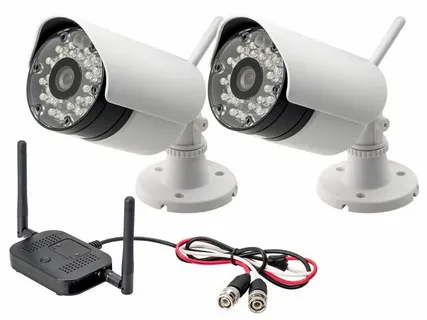How to Integrate IP Cameras into an Existing CCTV System?
Posted 3 months ago by Network Attach Storage / 30 views
Integrating IP cameras into an existing CCTV system is an effective way to upgrade your surveillance infrastructure without completely replacing the traditional setup. By partnering with a professional security company, you can ensure the seamless addition of these digital solutions, which enhance image quality, provide remote access, and incorporate advanced analytics into your security system. Proper planning and expertise are essential to guarantee compatibility and functionality.
Understanding the Basics of IP and Analog Systems
To integrate IP cameras into a traditional CCTV system, it is essential to understand the key differences between the two technologies. Analogue systems rely on coaxial cables to transmit video signals to a DVR (Digital Video Recorder), while IP cameras use network cables to send data to an NVR (Network Video Recorder).
Analog systems are known for their simplicity and reliability, while IP cameras offer superior resolution, remote accessibility, and advanced features like motion detection and video analytics. The goal of integration is to create a hybrid system that combines the strengths of both technologies.
Evaluating Your Current CCTV Setup
Before beginning the integration process, assess your existing CCTV system to determine its compatibility with IP cameras. Take inventory of the components, including the DVR, cables, and cameras, and check for available network connections.
Evaluate the capacity of your current DVR to ensure it can accommodate IP camera inputs. If your DVR is not compatible with network devices, you may need to consider using a hybrid DVR or adding a network video recorder to your system.
Choosing the Right IP Cameras
Selecting IP cameras that align with your security requirements and the existing system is critical for successful integration. Look for cameras with features like high-definition resolution, night vision, and wide-angle lenses. Ensure the chosen cameras support ONVIF (Open Network Video Interface Forum) standards, which facilitate compatibility between devices from different manufacturers.
Consider the environment where the cameras will be installed. Outdoor cameras should have weatherproof and vandal-resistant designs, while indoor cameras can focus more on aesthetics and discreet placement.
Incorporating a Hybrid DVR or NVR
To bridge the gap between analogue and IP cameras, you will need a recording solution that supports both technologies. Hybrid DVRs are designed for this purpose, allowing analogue cameras to coexist with IP cameras on the same system.
Alternatively, you can add an NVR to your setup for managing IP cameras exclusively. The NVR can work in conjunction with the existing DVR, creating a dual recording solution that enhances the overall functionality of your surveillance system.
Setting Up Network Infrastructure
Integrating IP cameras requires a reliable network infrastructure. Ensure you have sufficient bandwidth to handle the additional data from IP cameras. Use quality Ethernet cables, such as Cat5e or Cat6, to connect the cameras to your network.
A Power over Ethernet (PoE) switch simplifies installation by supplying power and data through a single cable, eliminating the need for separate power sources. This feature is particularly useful when deploying multiple IP cameras.
Configuring IP Cameras for Integration
Once the physical setup is complete, configure the IP cameras to work seamlessly with your existing CCTV system. Assign unique IP addresses to each camera and ensure they are within the same subnet as your NVR or hybrid DVR.
Access the cameras’ settings through a web browser or dedicated software provided by the manufacturer. Adjust parameters like resolution, frame rate, and compression format to optimize performance and storage efficiency.
Syncing Analog and IP Cameras
To achieve a unified surveillance system, sync the feeds from both analogue and IP Security cameras. Most hybrid DVRs and NVRs offer user-friendly interfaces for managing multiple video inputs. Organize the camera layout for easy monitoring and ensure all feeds are properly recorded.
Test the system to verify that both analogue and IP cameras are functioning correctly. Check for latency or compatibility issues and address them promptly to maintain a seamless viewing experience.
Integrating Smart Features
Adding IP cameras to your system opens the door to advanced surveillance features. Many IP cameras come equipped with motion detection, facial recognition, and object tracking. These capabilities enhance security by automating threat detection and reducing false alarms.
Consider integrating the system with mobile apps or cloud services for remote monitoring. This allows you to view live footage, receive alerts, and access recorded videos from anywhere, ensuring round-the-clock security.
Future-Proofing Your Surveillance System
Integrating IP cameras into an existing CCTV system is a step toward future-proofing your security infrastructure. As technology continues to evolve, a hybrid system provides the flexibility to incorporate new advancements without overhauling the entire setup.
Regularly update the firmware of your IP cameras and recording devices to maintain compatibility and security. Periodically assess your system’s performance and make upgrades as needed to address changing surveillance requirements.
Enhancing Security with a Hybrid Approach
The integration of IP cameras into a traditional CCTV system combines the reliability of analogue technology with the innovation of digital solutions. This hybrid approach maximizes the strengths of both systems, providing comprehensive coverage, superior image quality, and advanced features.
By carefully planning the integration process, choosing the right equipment, and optimizing the network infrastructure, you can create a surveillance system that meets your current needs and adapts to future challenges. With the right strategy, your upgraded security system will provide peace of mind and ensure the safety of your property and assets.
- Listing ID: 32779

